Marbeth Skwarczynski's Blog, page 9
October 25, 2022
Creative Refueling
Tuesday has become my favorite day of the week. It starts like every other day with marketing or writing as soon as I wake up. Then, I drink a cuppa and keep writing until noon when hubby encourages me to stop and take a break with him. But instead of returning to work after lunch, on Tuesdays, I get dressed up and we head out. Is it a date? Absolutely! But it’s also my chance to refill my creative tank.
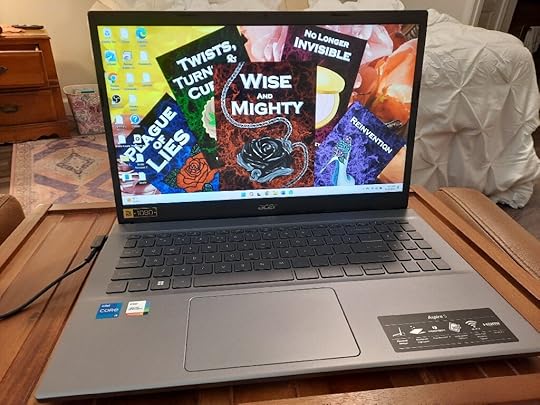
You see, Tuesday is discount day at most theaters. If I worked it just right, I could see multiple movies with various family members. Kid movie with my grandchild, an action-adventure or comedy with my husband, a science fiction film with my daughter-in-law, or a horror film with my son. I haven’t gotten all four in one day, but give me time. I’ll figure it out.
Our favorite local theater requires a ride “into the stars” on an escalator.

Once I step onto those moving steps, I start buzzing with excitement. I know I’m about to experience a fully-creative project featuring everything I enjoy — a well-written story creatively presented with talented actors and a perfectly timed musical score.
And popcorn. Can’t forget that.

My husband often remarks that I can usually find something in a movie to like — even if I don’t enjoy the overall project. It’s true. There have been very few movies where I’ve been so frustrated with the elements’ lack of cohesion that I’ve left the theater angry at the director and producers — especially if I’m familiar with the source material and can pinpoint where the screenwriter or director has done away with the basic themes so carefully crafted by the original writer and instead added nonsensical scenes that do nothing to push the story forward.
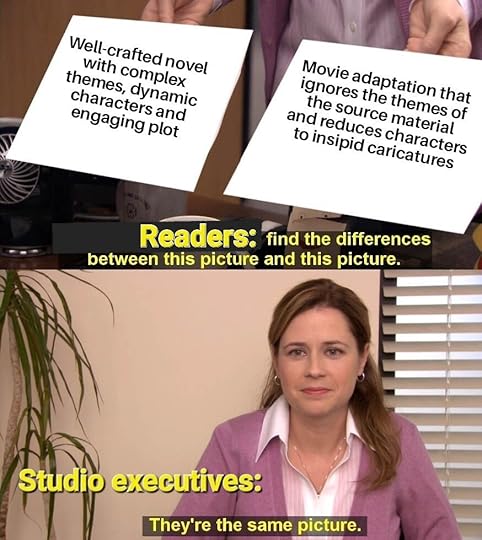
That frustration is rare, however.
I don’t look for absolute perfection in my movies. I recently watched one with my son where the acting, makeup, and music were all effective, but I felt the story had some significant holes. His response? It’s a horror movie. The story doesn’t need to make sense. When I disagreed, he suggested that the plot holes would be fixed in the sequel. I ended up thinking about the film for the next few days — not the gore and fright, but the plot. That movie, as imperfect as it was, sparked my creativity by compelling me to think through the storyline and the possible solutions to the problems I saw.
A week later, I watched a film with my husband where the main character routinely broke the fourth wall. My husband muttered, “Ugh, I hate when movies do this.” I was surprised by that since it’s such a great vehicle for storytelling. I tried not to let his obvious frustration with the film’s first half distract me. I was enjoying the movie. My husband was not. He later told me he took issue with the subject matter (alcoholism) and how lightly it was being handled. And then, halfway through, the whole tone of the movie began to change. He got into it. Afterward, we talked about the unreliable narrator, the use of the fourth wall break to tell a story, and how addiction is viewed by the addicted versus how it is seen from the outside. We agreed that the movie was a good one. It took us on a journey, bringing us into the experiences of the lead character, and prompting me to think about my own imaginary friends and how they view themselves.
Last week, I wrote a chapter of my WIP, then had to step away for a few minutes. I went back to the book and wrote for another hour before I had to stop again. My alarm went off, prompting me that it was time to post SOMETHING on social media, but I had nothing.
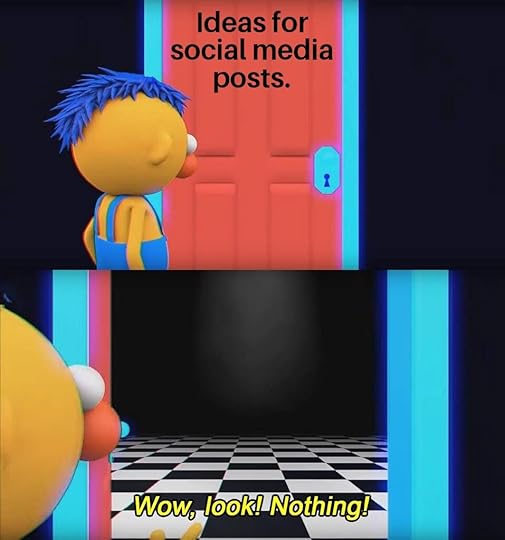
And then I remembered. Today is Tuesday. It’s movie day. That empty well of my creativity is ready to be filled by an imaginative and enjoyable theater experience. Tomorrow, I’ll return to my keyboard, ready to tackle the next few chapters of the novel — inspired by the creativity on screen.
You know what? It worked. Over the next several days, I wrote original chapters, solidified a character’s motivations, and researched an autoimmune disease. The story leaped forward.
The subject matter of my novels can get heavy, so taking time off to replenish my creativity works wonders.
You should try it.
 [image error]
[image error]
October 5, 2022
Riches in Readers
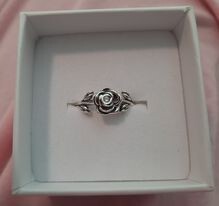
Most of us have heard the phrase, “There are riches in niches.” For writers, we hear, “Find your audience.” According to the agents I reached out to, having an audience — and a multimedia platform to draw them in — was of utmost importance. It was on me to locate that audience. And build the platform. And bring in the numbers. Oh! And WRITE THE BOOKS!
One agent gave good advice in a general interview when he suggested writers write for one specific person. Easy-peasy. I decided to write a book I wanted to read.
And that was before I heard the joke, “Write the book you want to read because you’ll read it a hundred times.”
Writing my first books took years and so many rewrites, I’ve lost count. Throughout those years, I’d submitted my work to various agencies, praying for a book deal where I could be guided through the publication process. The closest I got was a full-manuscript request for Twists, Turns, and Curves — with a few things to correct first: speed up the action between the two main characters, increase the conflict, and end the book at a wedding instead of a honeymoon. That last request hurt. The agent hadn’t read the original ending but wanted it replaced to follow a specific trope. I wrote an ending I never wanted and sent the manuscript on its way. It was rejected anyway. Thank God. I put my original ending back in ASAP.
My last attempt at traditional publishing was another hard edit of my first novel Plague of Lies and submitted to the biggest name among Christian agents. To ensure I did everything right, I watched the seminars he taught and read the pages of preferences his agency demanded I follow. I listened as he dragged writers who addressed envelopes by hand and praised those who sent their work in sleek boxes with neatly typed labels and the inclusion of his favorite candy. Above all else was the demand that his name be spelled correctly.
I submitted Plague of Lies as a New Adult novel. My main character turns 18 before her long-lost father contacts her. That bit of information drives the story. I sent my proposal on its way with a promise to myself. If it was rejected this time, I’d self-publish.
I kept that rejection letter on the counter for two years. I never read it. My husband read it to me while I chopped vegetables for dinner. My book wasn’t what the agent was looking for. He suggested I market it as YA instead of NA, even though it didn’t fit that genre. I shrugged and said, “I guess I’m self-publishing.” That’s when my husband showed me the salutation on the letter. The agent had misspelled my name.
I took that as a sign that I was on the right track.
Yet another edit (there is ALWAYS another edit) and I started the terrifying process of formatting my novel on Kindle Create before having it published through Amazon in September 2020.
While editing book two, I did promotions for book one, starting with FB and Twitter. I got some good feedback from Plague of Lies but got even more from Twists, Turns, and Curves.
And there it was — my audience.
It was made up of people like me who had plenty to say about the practices in their local church but had no real way to communicate their observations. They were several degrees removed from any church leaders who might listen to them and bring about the desired changes. Others were condescendingly tolerated as they pleaded for leadership to protect their flock, then were ignored as wolves continued to roam throughout the congregation, led music, made announcements from the platform, and even preached. Some readers were bluntly instructed to sit/work in silence. Our expressions of faith and the desire to use our gifts were circumvented by man-driven rules and standards that seemed to govern only the congregation, not the leaders.
My audience LOVED Caroline Taft for her sweet spirit but also for her backbone. She was the friend we all wanted. They adored Nana for swooping in as a rescuer. They cried with Michael as he recalled his abuse at the hands of a church worker. They begged Jason to open his eyes and cut ties with evil men. I try to keep my novels as realistic as possible because I believe there is truth in fiction.
As my writing continued, I expanded my platform to include blog sites like Medium and WordPress. I joined Instagram. I’m doing my best to come up with daily stories, reels, and posts. It’s time-consuming. I have to make time to write.
Last month, I launched book 5 of The Rose Collection. I’m currently combing through the early drafts of book six, trying to create a tight story out of chaos.
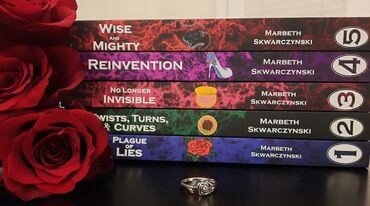
With each book I publish, I find a new reader or two. They are usually men and women who have experienced spiritual abuse and are recovering, becoming stronger than ever. They are Bible believers whose faith was shaken by their local churches rather than by the world. Instead of rejecting Scripture, they have chosen to read and study for themselves. Rather than rely on religious leaders whose roots and fruit have proven to be rotten, they are sending up shoots of new growth.
The best part? They reach out to me. I have pages of text on my phone from readers who read my books, saw their stories on the pages, and want to let me know how much they appreciate the truth coming out. They go on to tell me of their own heartbreaking experiences, many of which are far more disturbing than anything I could dream up for a novel. Some of those readers have become my online friends and we have great conversations.
My audience is small but wonderful. They “get” my niche and pass information about my books to their fellow survivors. I couldn’t ask for a better readership.
They are who I write for. They are my audience. Because of them, I’ll keep writing and communicating, digging deeper into the issues that shape our world.
I’ll keep mining those niches where my readers are the riches.
https://www.amazon.com/Marbeth-Skwarczynski/e/B0964C6MMN?ref=sr_ntt_srch_lnk_1&qid=1665006414&sr=8-1
[image error]October 4, 2022
I, Character

As a writer, I am often mistaken for my characters. But while it is true that we share many of the same characteristics, motivations, music preferences, and language patterns, I am not my characters and they are not me.
The similarities are easy to explain: we all share a brain.
This means I have clarity about each character’s motivations, fears, frustrations, goals, and desires. That doesn’t mean those aspects are carbon copies of my personality traits. You see, once the pieces start coming together, something amazing happens. The character takes on a life of its own. At that point, it begins to create pieces for itself. It embarks on a path that may take it far from the destination I intended and starts a butterfly effect that can change the entire novel.
I LOVE it when that happens. It means I’ve done something right. Characters grow and expand away from their “mini-me” mold and shatter it into a thousand pieces. Then they gather those shards to create a mosaic that is all their own. While I share similarities with pieces of the character, they are wholly original.
In Plague of Lies, I understand Lauren’s feelings of not being wanted, but I’m not a retro-goth-glam girl who was abandoned by her father and bullied her whole life. I didn’t spend my senior year living in an RV in the backyard after my grandfather moved into the house and didn’t jump on a bus at 18 to hunt down my birth father. That’s Lauren, not me.
I get Caroline’s frustrated exhaustion in Twists, Turns, and Curves. I too spent years as a professional educator living in poverty, thinking I was doing it for God’s glory. But I’m not nearly as talented as Caroline. I’d be completely lost in her alternate profession. It took me years to discover a new career for myself.
I felt closest to Julia Williams when writing her story in No Longer Invisible because I too believed there was safety in invisibility. I didn’t have to worry about out-of-control physical abuse, though. I learned to keep my head down so it didn’t get bitten off. I tried to stay quiet, but it wasn’t my personality, so my silence would erupt in explosions of awkwardness. I still fight that anti-social part of myself that isn’t quite sure how to behave. Julia more easily embraces the gift of reclaiming power through quiet observation.
As for Ally James? I’m not a semi-retired model who is now part owner of a fabulous line of curvy girl boutiques (although the AXIOm system is definitely mine). In fact, I’m less like Ally than any of my MFCs and that’s okay. It’s more like she’s who I can aspire to be — hard-working and empathetic. But, when it comes to the MMC of the novel, I can easily relate. I’ve had triggers activated in public. I’ve had anxiety and panic attacks creep up on me out of the blue; wheels set to spinning with no more provocation than an errant thought. But I’m not a bookstore owner in a mountain-top city dealing with vestiges of trauma left by sexual abuse.
Kelly Taylor and I share many similarities — to the point where close friends who have read Wise and Mighty declare confidentiality that we are one and the same. But we’re not. Kelly is more outspoken than I am. She’s more confident in her abilities. Kelly has the opportunity to be a leader and she does it well. Me? Not so much.
I speak up primarily through novels. They are how I attempt, in my small way, to lead. To shout.
Because I wrote each book in “real life,” they can’t help but follow the thread of my own experiences. I too witnessed betrayal and cover-up at the leadership level of a church. I saw the righteous anger it sparked. I experienced its destructiveness.
After a decade-and-a-half of living in poverty conditions while working as a professional educator, my husband and I were finally making enough money to breathe. Of course, it also meant he was never off the clock and a large chunk of our pay went to helping another struggling teacher's family.
As a young mom, I read To Train Up a Child and was horrified that my church would endorse it. I couldn’t understand why anyone would use what was obviously a punishment-based puppy-training manual on their child. But, I knew people who did. Since they were church leaders and the book was church-recommended, I didn’t understand at the time that what I was seeing was abusive. Now I do. I can’t go back in time and fix my reactions, but I can apologize for my part in a child’s pain and give proper words to what they’ve gone through. It wasn’t discipline. It wasn’t even punishment. Spanking a child until they cry “properly and with a broken spirit” is abuse.
As a writer of books centered on recovery from spiritual abuse, I use my own journey as a template, but listening to others as they reveal their own experiences has made me more empathetic. Not everyone can tell their stories. Not everyone has the words. Thankfully, safe spaces are becoming more available. Readers can message an author and say, “I saw myself in that character. I went through something similar. I’m making changes so I can live my best life.”
This brings me to my own changes that are reflected in Wise and Mighty. I too occupied a different emotional, mental, and spiritual state than my spouse when it came to dealing with issues in our denomination. I once felt the way he did. I believed there were enough good people to save what I was convinced to be a God-ordained system. For years I worked within those set parameters to change things for the better, but after three decades of attending and working for what I thought was God’s ministry, I finally realized that the organization was more about propping up church leadership. Once that piece fell into place, I could finally understand the lack of Bible preaching and teaching, the push for attendance numbers, the exaggeration of our church’s influence and outreach, the constant fawning over men with bigger ministries, and the quiet determination to keep women in their place with exaggerated flattery and lack of real leadership roles.
I left. I got out. That was when I could finally acknowledge the toxic system I’d been a part of.
I wish I could have lived Kelly’s resolution, but it was not to be. Instead, I watched my sons move out of state, in large part to protect their families. I watched my husband struggle with the knowledge that I might be right even as he continued working nearly 60 hours a week in full-time Christian service.
He finally got out, and like our sons, we too moved away. Away from our “forever home.” Away from my amazing sister (who I miss every day). Away from our few cherished friends. We were able to move close to one son, but the other is on the opposite side of the country.
Kelly got to keep her church family. She got to build and rebuild friendships. She got to protect her family and keep them close by. She got to be a spiritual leader in a church that actually WANTED to do better, whose pastor created a safe space where people could worship, fellowship, and learn together. Kelly gets the dream and I couldn’t be happier for her.
But like all of my other main characters, Kelly is not me.
As a writer, I don’t get a happily ever after. Instead, I get more pieces. Some belong to the puzzle of the plot, others to setting. But, the pieces that come together first belong to yet another character. I may not know who it is at the beginning, but I’ll add a piece of myself here and there until enough of me is in the mix to bring her to life. At that point, I’ll watch as she claims her own power to tell her own story. She will become someone else.
Not me.
https://www.amazon.com/kindle-dbs/author/ref=dbs_m_mng_wam_byln?_encoding=UTF8&asin=B0964C6MMN
[image error]September 14, 2022
The Curvy Girls Continue On

The Curvy Girls promotion run by Heidi Gray McGill is wrapping up, but the impact of plus-sized women on Christian fiction will continue to grow and evolve.
As a participant in this promotion, I took advantage of the resources available and read several of the books recommended. Starting with:
Nicole: A Sweet Romantic Comedy (Sewing in SoCal book 3)
Like every genre, romance has its hits and misses.My first thought when I started reading Nicole by Sarah Monzon was “Oh, thank goodness, this is a good one.” That initial observation soon changed to “This is great!” It didn’t take long to read since it pre-empted a large portion of my sleep schedule.The FMC is a curvy single mom of an eight-year-old girl. She has a great job, a slew of close friends, and a passionate intensity for God’s creation and social justice. But, her passion has become a way of closing herself off. Even with Drew, a handsome doctor and the new football coach of her daughter’s team, her seriousness gives way to a prickly attitude more often than not.Add to that her self-consciousness over her pear-shaped figure and she knows she can chase an unworthy man away with a few harsh statements about the environment rather than letting him point out her perceived physical flaws.But Drew doesn’t see her shape as flawed. In his mind, she’s as gorgeous as a 1950s pinup fantasy girl, but with the added benefits of flesh-and-blood beauty mixed with a generous dollop of intelligence and passion. He sees that she’s a fantastic mom and a loving friend. There’s only one thing he’d change about her…he wants to show her how to have fun.Great book!It was a great start, and I found a wonderful new author to follow! Next, I read this gem:
Count Me In (An Emerald City Romance Book 1)
Allegra has always been the responsible one in her family. That role intensified when she began raising her sister after their parents’ accidental deaths. Now her sister is in design school, and Allegra is working as an accountant. It’s a nice, safe life until the firm Allegra works for closes without warning. Determined to prevent her sister from racking up debt by taking out loans, Allegra accepts the first job offered to her so she can pay the tuition.Suddenly, the least adventurous person in the world is an accountant for an outdoor adventure company. It’s so not her thing — but working for a gorgeous retired NFL player, Tyler Hawk, sure helps. Unfortunately for Allegra, Tyler’s goal in life is to help people conquer their fears. Allegra’s fears are legion, but she’s determined to keep the job, despite the clause requiring her to go on some of the company’s adventures herself.Tyler Hawk built his career on the adrenaline rush of adventure and has no patience with those who let fear dictate their lives. When he meets the voluptuous Allegra, he wants to draw her out, show her the beauty of God’s creation, and encourage her to leave her fears behind. But, when he realizes he’s developing feelings for his new employee, Tyler’s own fears bubble up to the surface.My next choice was:
Raindrops on Radishes: A Christian Romance (Urban Farm Fresh Romance Book 6)
Sadie Guthrie is struggling. Her challenging work as a family law attorney tends to keep her own family issues front and center. When she isn’t working, she just wants to rest with her cat, a book, and a sweet treat. She bought her new house, intending to make it an oasis of relaxation. Especially the backyard. Beds of flowers to scent the air, a trickling water feature, and a patio in keeping with her newly-purchased heritage home sounded perfect. But, her plans are disrupted by the next-door neighbor who claims he had an arrangement with the former landowner.Peter Santoro is struggling. His challenging work with the Fish and Wildlife department is just one of his jobs. He sinks every spare minute into the new company he started with his cousins: Bridgeview Backyards. Together they grow garden produce in participating backyards. But, out of the blue, one of those yards — one he’d had arranged to purchase — is sold instead to someone not willing to continue the arrangement.As these two struggling people attempt to deal with lives too full of work, busyness, and poor choices, they come to realize there is also a spark between them. But can two unhealthy people ever have a healthy relationship?And, of course, I read Heidi Gray McGill’s book! (Which is now a best-seller, so WHOOP-WHOOP!)
Dial P for Perfect: Sweet Christian Contemporary Romance Novella (You Are on the Air, Book 11)
Ginger loves her life. She’s developed a business that allows her to work from home and set her own hours, she has a precious cat named Snickers, and she has a church family with whom she can worship and grow spiritually. As for a romantic relationship? She had her eye on a guy a few years ago, but he only had eyes for her best friend.But Ginger couldn’t blame him. Her friend is gorgeous. Ginger is — pretty. Not bad-looking if the guy doesn’t mind a curvy girl. Or, as Ginger labels herself, “big.”Still, an occasional date would be nice — not easy in a small town — and her friends seem to enjoy the challenge of setting her up.Like meeting newcomer Reggie at her small group. True, there were no sparks, but at least Reggie was polite to her and didn’t make her feel like her weight was a deal-breaker. Of course, he wasn’t much to look at either.But is that all Ginger could anticipate for her future? A guy who “accepts” her despite her flaws? Is it too much to ask for a guy who thinks she is beautiful and perfect?But, then again, shouldn’t Ginger look at HERSELF as perfect? After all, that’s the way God sees her. And HE loves her just as she is.Then there was this enjoyable novel:
The Breakup Project (Original Six Hockey Romance series Book 1)
Breanna Karlsson is bubbly, kind, and empathetic. Those who work with her in early-childhood education see those characteristics as part of her dedication and focus. The children under her care feel safe and encouraged. When it comes to family, however, Breanna’s personality comes off as — flaky. Her parents wonder if she takes on more than she can handle. Her twin brother teases her about never being able to keep a New Year’s resolution, implying that she’s unable to finish anything she starts. As for her love life? Well, when your twin is a famous hockey player, it can be difficult to find a guy who wants to date you for yourself, not for your connections.But, this year will be different. Breanna has resolved to spend a year not dating any hockey players. It should be an easy resolution to keep — especially when she realizes her twin has gotten himself into a cringey relationship that promises him nothing but pain.Breanna reaches out to her brother’s best friend and fellow hockey player, Mike Vaughan, and reveals her plan for a breakup project. Between the two of them, they can look out for Brent and encourage him to get back on track.Mike is more than willing to help Breanna with her brother — he’s a little worried about Brent too — but that’s not the real reason he wants to maintain his newly re-established communication with Bree. He’s been in love with her for years.But Brent has told him that Bree is off limits.And Bree has made her resolution…Finally, today, I finished this incredible book:
The two writers of very different backgrounds should have met long ago. Flynn Ferguson attends the kirk, where Brodie Maclean’s father is the pastor. Flynn also has an excellent relationship with Brodie’s mother and his sister, Catriona, who runs “messy” church for the disabled persons of the parish. Flynn appreciates the church’s outreach to the differently abled since her daughter Logan struggles with complications she’d incurred as a premie, including intense bouts of asthma that tend to put her into the hospital. Flynn knows about Brodie, of course; she’s read a few of his dark mystery novels. They aren’t quite her taste. She tends to write sweet romances herself.Despite knowing Brodie’s reputation as a bitter, twisted ogre of a man, Flynn takes a job as Brodie’s temporary housekeeper. The position comes with a list of non-negotiable rules, but Flynn needs the money. Logan’s birthday is coming up, but more importantly, they really need a new place to live. Flynn shows up at her new job and is shocked by the pain showing on her new employer’s face. Brodie, who has cerebral palsy, has just had extensive kidney surgery and is still recovering. The empathy Flynn shows to her daughter flows easily toward this man who spends his days in front of a laptop.The last thing Brodie needs is sympathy, and it’s a good thing. He’s so terse that most people avoid him, and that’s fine with him. He doesn’t need people, either. Actually, all he needs to get back to work is complete quiet, no distractions, and a clean, uncluttered environment. Things no substitute cleaner has been able to give him so far.Flynn can provide him with the housekeeping services he requires, but she can’t help being a distraction. Especially when Brodie discovers that Flynn is living a lie that treads too closely to his own double life.An excellent story. Highly recommended!Two of my own books were part of the Curvy Girl Promotion.
Twists, Turns, & Curves (The Rose Collection Book 2)
Caroline Taft did her best to live a life of service and sacrifice, “above reproach,” but when her teaching career at Benchmark Baptist Christian School is cut short, she discovers that she hasn’t lived much of a life at all. Despite going on visitation every Saturday, teaching Sunday school, singing in the choir, directing children’s music, leading Wednesday’s Bible club, and, of course, teaching fourth grade (her actual job), it isn’t enough to keep her on. She wonders if it isn’t what she has or hasn’t done or if it’s her weight. Caroline is one of the few plus-sized women in her church and the only one on staff. Despite her discipline and hard work, her weight has made her a target. She has no savings, no apartment of her own, and her only close friend is the fellow teacher assigned to be her roommate. Her love life is non-existent. But maybe, just maybe, this abrupt change is just what she needs to break out of the mold she’s was shoved into for so long. It’s time for a new job, new clothes, a new home, and a new chance at love.Maybe it’s even time to approach Ty Lang, the uncle of one of her students and a man she’s secretly admired for two years. He’s kind, successful, and sweet — and entirely out of her league. Her life may hold some twists and turns, but now it’s time for Caroline to throw some curves of her own.Reinvention (The Rose Collection Book 4)
Dawes is a great place to hide.As the owner of Twice-Turned Books, Michael Bernard, spends his days surrounded by gently used volumes and people who love to read. He can pretend his past trauma never happened in this peaceful mountain city.Ally James is working across the mall, a part-time clerk at Vivid, a curvy girls’ clothing boutique. Ally believes in the company and its mission to help women look and feel their best — just as they are — and it’s the perfect job for a woman escaping from the past she outgrew.When Michael and Ally first met, they were relieved to discover another person in Dawes who wasn’t ready for romance. Each has hurts that are still too tender, too sore. So instead, they focus on friendship as they attempt to move into the future.It turns out that Dawes is a great place to heal as well.Until a voice from the past puts Michael and Ally’s friendship to the test.Yesterday, I released the newest book of The Rose Collection. My FMC would be right at home with the other heroines of the Curvy Girl Promotion.
Wise and Mighty (The Rose Collection Book 5)
Sometimes the hardest thing to do is walk away.Pastor Jason Taylor wants to believe that most people in his circle of fellowship are good — that they want to serve God and each other. But now, the evidence is piling up. Crimes are coming to light, victims are finding their voices, and Jason is trying to figure out what to do next. He’s determined to fix his denomination and make it a safe space for everyone.Kelly Taylor believes the denomination is beyond redemption. She feels like she has been pointing out every red flag she’s seen but to no effect. She does what she can to protect the women in her church, her sons, and her husband, but it seems like the one thing she can’t do is get Jason to see the problems right in front of him. These issues have been plaguing the churches in their circle for years — both perpetrated and hidden by those in leadership.As much as Jason and Kelly love each other, they are not seeing eye-to-eye on this issue. They tread carefully through their marriage, but the frustrations they feel are always bubbling just under the surface.Although the promotion is almost over, I still have more books to read and more authors to explore. I was close, but I just couldn’t read fast enough!
Here are the titles I just couldn’t get to:
Hope Unashamed (For Every Love Book 2)
He’s never been so mesmerized by a girl before…Arthur is a studious, “all or nothing” kind of guy with his life planned out. Even before he’s old enough to drive a car, he knows he wants a career in computers. Since he sees no need for romance until he’s ready for marriage, Arthur keeps his focus on his education.Then, a new school year brings a stunning young lady into Arthur’s path, blindsiding his ideas on romance. As a result, his transition from boyhood to manhood includes the pursuit of the woman he wishes to make his wife. But when his pursuit falls through, Arthur must realize when it’s time to give up the shame of a broken dream — and learn what it truly means to hope for more.
Embracing the Outcast (Crowns Legacy Book 2)
They can only experience beauty if they dare to behold it…Now that Princess Eunice of Diachona has come of age, she has much more to study, and a new weight sits on her compassionate shoulders. Her late mother was an admirable ruler, but Eunice can hardly see herself thriving in the political arena. In fact, she doesn’t think many people see her at all, especially not would-be suitors who often bypass quiet Eunice to pursue ladies they find more attractive.So when Eunice meets a serious, gifted artist who expresses his desire for her company, she isn’t sure if his interest in her is romantic or simply artistic. And why does this young man seem to be as saddened by Eunice as he is drawn to her?Between his pride and her prejudice, there could hardly be a less likely couple.When their best friends’ summer wedding in London pushes proud judgmental medical missionary Matthew Coalbrooke and bubbly plus sized shoe-aholic kitchenware saleswoman Anita Kiernan together, it’s dislike at first sight. Turning up at the airport with a toddler in tow doesn’t exactly help matters. The only thing they can both agree on is that the bride and groom’s matchmaking attempts are bound to fail.Neither are looking for love. He’s determined to return to his African mission hospital as soon as he can, where her glamorous presence would be nothing but a nuisance. She’s determined to care for her niece while her sister is ill, and besides, she has a shoe collection to maintain. An obnoxious, arrogant doctor is the last man she needs.But by the end of the summer, they’ll both discover God has a bigger plan for them than they can possibly imagine!
I hope you’ll take advantage of the promotion’s last hours to find a few new authors! Just click on the link below!
[image error]September 12, 2022
The Curvy Girl Finds Respect


While the primary theme of The Rose Collection, is recovery from spiritual abuse, a secondary theme throughout the Christian fiction series is reclaiming the respect one deserves.
For Kelly Taylor in Wise and Mighty, respect — or the lack of it — is just one of the problems facing the women of her church.
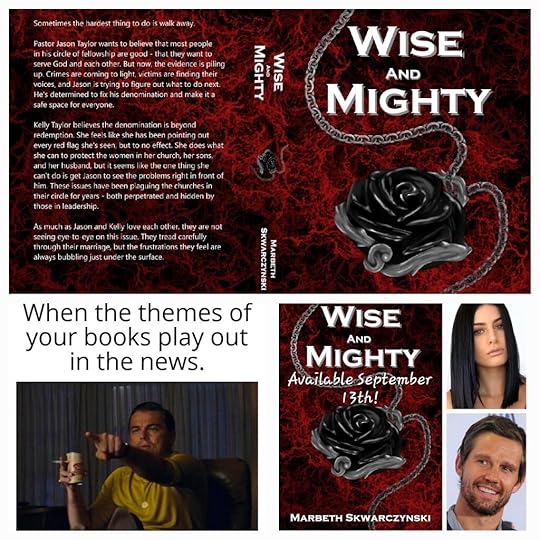 Wise and Mighty
Wise and MightyThe fifth novel of The Rose Collection follows Pastor Jason Taylor and his wife Kelly as they struggle over how to deal with bad news concerning their religious denomination. My synopsis of the story is pretty straightforward:
Sometimes the hardest thing to do is walk away.
Pastor Jason Taylor wants to believe that most people in his circle of fellowship are good — that they want to serve God and each other. But now, the evidence is piling up. Crimes are coming to light, victims are finding their voices, and Jason is trying to figure out what to do next. He’s determined to fix his denomination and make it a safe space for everyone.
Kelly Taylor believes the denomination is beyond redemption. She feels like she has been pointing out every red flag she’s seen but to no effect. She does what she can to protect the women in her church, her sons, and her husband, but it seems like the one thing she can’t do is get Jason to see the problems right in front of him. These issues have been plaguing the churches in their circle for years — both perpetrated and hidden by those in leadership.
As much as Jason and Kelly love each other, they are not seeing eye-to-eye on this issue. They tread carefully through their marriage, but the frustrations they feel are always bubbling just under the surface.
Wise and Mighty (The Rose Collection Book 5)
For my curvy girl heroine, the solution to the fictional denomination’s (or “movement,” as they like to say) problem is a no-brainer. If evil is found, The organization must cut it out. If the organization refuses, then it’s up to the individual churches and their members to leave. It's a simple solution — and so obvious that Kelly can’t understand why her husband won’t see it.
What isn’t so simple is untangling the threads of man-made teachings that have encircled their churches. It has become almost impossible for individual members to correctly separate preference-based preaching by controlling religious leaders from the truth of actual Bible teaching.
Kelly has been disentangling for years — and writing about what she’s found. Every night, Kelly opens her laptop to write what she is learning from God’s Word. Four times a year, she has her work printed and bound, ready to be used by her Wise Women’s Sunday school class. Most of the Wise Women are single — unmarried, divorced, or widowed — and have flocked to Crystal Falls Baptist because of its reputation as a safe place. Many of her students left home churches that treated single women as servants waiting for redemption by the “right man.” At Crystal Falls, however, those same women are seen as loved and important church members whose opinions and talents are appreciated.
But while the women in the class feel appreciated and heard, Kelly does not. As the pastor’s wife, she’s constantly walking the multi-strand wire of supporting her husband’s ministry, keeping her home a haven, protecting her sons, guarding the women of her church, and waging an undercover defensive war against an increasingly out-of-control movement that wants to destroy it all.
The only time Kelly doesn’t feel like she’s on the front lines is when she’s working at the public library as the assistant librarian. There she feels respected and honored. It all seems so backward somehow. Shouldn’t she, as a Christian woman, feel more protected, loved, and respected in her home and church than in her “worldly” place of work?
When her husband, Jason, finally begins to understand the depth of evil in the hearts of their denomination’s leadership, he also begins to acknowledge the problems that Kelly has been pointing out for years — including the issue of preferential dress standards being used to discourage women’s involvement. Women attending church to worship, learn, and fellowship are distracted from the true purpose of believers assembling together. Instead, they tie themselves into knots trying to follow each new “standard.” If a man from behind a pulpit claims that red nail polish is “tempting,” then the women in the congregation worry and condemn themselves until they can make the switch to pink or clear, wondering who they may have unintentionally tempted before they knew. If knee-length skirts are deemed too short, then ankle-length become the standard. If a ponytail is considered “too sporty” in the eyes of those in leadership, then elaborate braiding or updos become the norm. The focus is so adamantly on the outside appearance of a person that it is nearly impossible for other inward changes to take place. Even worse? When those rules zero in on the body, declaring it tempting and therefore sinful, they create a logical “excuse” for abuse. Outward change is demanded from leadership while Bible study of any depth goes untaught.
Those who never imagined they could be considered “tempting” take on the observer’s guilt. It is up to them to dress “properly,” stay home, and act “modestly,” never drawing attention to themselves. If they are assaulted or abused, it must be because they tempted a “man (or woman) of God” beyond what they could stand.
The message becomes clear: keep quiet, modest, and sweet. Don’t draw attention by trying to lead. If something bad happens to you, it’s because you did something wrong. Keep your head down and do what you’re told. Or, as Kelly tells Jason and her sons at a family meeting:
“But the AFB isn’t just keeping women from teaching; it also controls how we act, what we say, and even how we look. Our church is more relaxed regarding dress standards because we trust the people of our congregation to dress as they see fit. They don’t need anyone to tell them what to wear. But that isn’t the case in most AFB churches. At the different conferences and rallies we’ve attended, you may have noticed that while some of the girls are wearing somewhat normal clothes, many are wearing long, heavy skirts or dresses in plain colors. Some keep their hair long and don’t wear makeup or nail polish. All of that is because their church has set that standard. If people want to feel welcomed at their services, they must follow those rules. A woman’s spirituality is judged as good or bad simply by what she wears or how she looks. Not by how she lives or acts.”
Kelly’s size 14 X-shaped figure had prompted her to stand up against ridiculous dress standards years before, but she’s a lone voice in the wilderness when it comes to the fictional American Fundamental Baptist movement. Keeping the focus on “standards” (dress or otherwise) translates into a few leaders exerting their power over the entire denomination. And Kelly is sick of it.
Over time (almost a decade, in fact), I realized that some people are never happy. They won’t be satisfied, and attempting to please them wastes time. If they approve of the length of the skirt, they’ll fuss about how tight it is over the hips and bottom. If the dress or skirt is flowy enough, it will be the wrong color or show off the body’s shape “too much.”
That whole “showing off her body shape” rant that went through our circles a few years ago was the last straw in my overly packed basket. There is absolutely nothing I can do about my shape. Nothing. No diet is going to change the fact that I have a large bust and hips with a smaller waist. So sorry if the male leadership in our circles can’t handle my “X” shape, but I’m not going to wear shapeless, baggy clothing, so they don’t “stumble.” I’m not in charge of their dirty minds. Besides, as I said before, it wouldn’t matter if I did dress like a frump. They’d still find something to criticize (and another reason to be “tempted” ). So now, when I waltz into the Vivid in Dawes, I grab a bunch of “X” shaped clothing off the rack and head for the dressing room, confident that I’ll look good in clothing made for my figure. I’ve freed myself to wear whatever I like and find appropriate while ignoring the perpetually offended.
Kelly’s practice of wearing clothing made for her body type is her silent way of saying she’s not buying into the nonsense being taught. Her biblically-based writing is about change on a deeper, more spiritual level. Writing is how Kelly shouts for change.
The biggest change Kelly wants to see is closer to home. She longs for her husband to open his eyes — about the denomination he’s defended for far too long, but more importantly, about her.
Kelly wants Jason to see that when he’s ready to make the right decision, she’s ready to fight by his side. She wants to be his partner in every sense of the word.
Kelly knows that Jason loves her but also acknowledges that he doesn’t always respect her. That hurts more than anything else the AFB has done to her.
Real denominations and movements that are run like my fictional AFB make it hard for a woman like Kelly to feel respected, even in her home. I’ve been in several Baptist denominations growing up, and while I appreciate their stated biblically-based distinctives, I have a big problem with how they view women. I let this show plainly in Wise and Mighty.
Kelly has been writing the Sunday school curriculum for her Wise Women class for seventeen years. Jason hasn’t bothered to read any of her books. After a family meeting, he pulls one of her spiral-bound booklets out at random and reads a single lesson. To his surprise, it’s good, and he finally confesses that he’s sorry he hasn’t read any of Kelly’s work before.
He’s sitting at his desk, head in his hands, staring at a spiral-bound book opened flat in front of him. It’s one of mine. “Jason?” His head jerks up, and he rubs his eyes with the heels of his hands before he smiles and waves me in, but I lean on the doorpost instead. He’s still unfocused, so I say, “Jason? Are you …”
“What a day, huh?” He interrupts.
“Yeah. Coming to bed soon?”
“No. Not yet.” He gestures at the pages in front of him. “This is good.”
“Thanks.”
“I’m sorry.”
“For what?”
“Not having read it before.” He gestures to the shelf under the window. “For not having read any of them.”
“That’s okay,” I shrug as if it doesn’t kill me a little inside every time I think about how my husband won’t read my work.
“No, it’s not. I don’t know why I haven’t.”
“Plausible deniability.”
“What?”
I force a laugh. “If you don’t know what your wife is writing, you can’t be blamed, can you?”
“Is that what you think?”
I don’t answer, but of course, it’s what I think. But, more than that, it’s what I know.
Later, Jason is challenged by one of his wife’s students to read from a specific booklet. To his surprise, the study opens with a chapter about the “Sister Disciples,” a title that wouldn’t be appreciated in their circles since everyone knows the “Disciples” were manly men.
I wipe my fingers carefully and open the cover of Kelly’s book. She even has a table of contents. I find the lesson Ginger wrote on her note to me and flip to the corresponding page.
Finally Obedient:
After three weeks of neglecting to follow even the simplest of directions, Christ’s Disciples finally arrive in Galilee.
One sentence in, and I’m already lost. So, I flip back a few pages until I see,
“This is now the third time that Jesus has reminded His disciples that they were instructed to ‘go before’ Him into Galilee.”
I flip back a few more pages, then shrug and open the book at the beginning. I know it will deal with the usual “spring” subjects such as the crucifixion and resurrection, so I shouldn’t be this thrown off. Okay, C hapter One: The Sister Disciples. What? I’m completely lost now. What sister disciples? What is Kelly thinking? I go back to read the opening verses of the chapter and relax.
Now it came to pass, as they went, that he entered into a certain village: and a certain woman named Martha received him into her house. And she had a sister called Mary, which also sat at Jesus’ feet, and heard his word. (Luke 10:38–39)
Oh. It’s about Mary and Martha. Kelly makes some interesting points, like how Jesus had up to 120 disciples who went out to villages as an “advance team,” preparing people for Jesus’ arrival with His closer circle of twelve. She rightly states that some of those 120, and a closer-knit 70, were women who supported Christ’s ministry. This first chapter focuses on Martha, homeowner and hostess extraordinaire, and Mary, who is pictured sitting in the posture of a disciple at Jesus’ feet. But Kelly doesn’t stop there. She claims that the three stories in the Bible concerning the sisters (or “sister disciples,” if you will) fit together to tell an overarching story of spiritual growth. The first part, about how Martha gets angry at Mary for not helping, is pretty much what I’ve always heard, but with a bit of salty commentary about how today’s religious leaders often refer to Martha. I get the frustration. Women in a church are always approached to take on one more responsibility, then get slammed from the pulpit as they are told, “Don’t be a Martha, be a Mary.”
Too many times, I heard that exact phrase pronounced from the pulpit. Yet, as a woman in the congregation (and on the church’s school staff), the expectation was quite different.
For me, the expectation was to teach full-time (but be viewed/paid as part-time since I worked at home rather than on campus during the summer) AND have a handful of church ministries to juggle.
Over the years, I taught Sunday school, led music in junior church, sang as part of the choir and as a soloist, started and taught Adventure Bible Club for the 3–6th graders on Wednesday nights, served shifts in the nursery, and did all the “unofficial” duties like helping out with potlucks. I lived in a state of perpetual exhaustion, too tired to think or question. After my church duties, any energy I had left over after being a mom and wife went right into my career as a Christian school teacher.
For the most part, I enjoyed teaching and loved my students, but no one can keep up that kind of pace and be mentally and physically healthy. I began to hate my life and spent years battling depression.
My summers were not set aside for rest and relaxation — or, more importantly, for healing. Instead, they were devoted to preparing for the next year. I spent hundreds of hours each summer making lectures, tests, study sheets, and (eventually) textbooks. I don’t regret creating those materials, as they made my life in the classroom so much easier, but the reactions my work got from some of my bosses and my fellow teachers were shrugs and the strong implication that I’d wasted my time. One boss even asked why I didn’t just read out of the textbooks they ordered from ABeka. Honestly, that question threw me so badly that I’m not sure If I ever gave him a coherent answer.
 Literature textbooks and history workbooks
Literature textbooks and history workbooksWomen like me — like Kelly Taylor — aren’t asking for the world. We simply want some respect. It isn’t easy to come by. I was in my thirties and working part-time at a community college library the first time I had a boss pull me aside to tell me I was doing a good job and that he appreciated my work ethic. After I stammered out a “thank you,” I immediately defaulted to my awkward self and added, “I’ve never had a boss tell me that before!” His returning look was quizzical, but he reiterated his appreciation and went on his way, leaving me to ponder the rarity of such an interaction.
Is it so difficult for us to thank others for what they do? To tell someone that we appreciate the time and effort they’ve put into their work? To compliment someone on their talent? To listen as someone in pain pours out their heart? To help someone find their rest? To let someone know that we see them?
Wise and Mighty isn’t only about Kelly’s quest for respect, but it does play a big part in her denominational deconstruction. She wants to be seen as something other than a skirt length, hairstyle, or body shape.
God made her — and all of us — to be so much more.
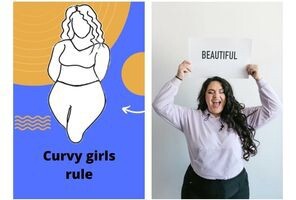
For some incredible books featuring curvy girl heroines finding the respect they deserve, check out the Curvy Girl Promotion here:
[image error]September 9, 2022
The Literary Embodiment of the Curvy Girl
The first time I sent a curvy-girl-themed book to an agent, I got a strange response back. He wanted more concrete descriptions of what my FMC went through daily as a plus-sized woman. According to his reading, she was just a normal person.
Huh.
A plus-sized woman being considered “normal”? Can’t have that, now, can we?
Nope.
She needs to be food obsessed, short of breath, perpetually sweaty, and utterly unattractive to anyone not willing to see beyond her flaws. She must also be on the “road to recovery,” under a doctor’s care, and losing weight by the end of the book.
My characters don’t really follow those guidelines. Instead, they eat food that is available to them and exercise when they can.
You know, like normal people.
Caroline eats cheap but filling items that she can afford on a low-income budget. She also hits the gym a few times a week.
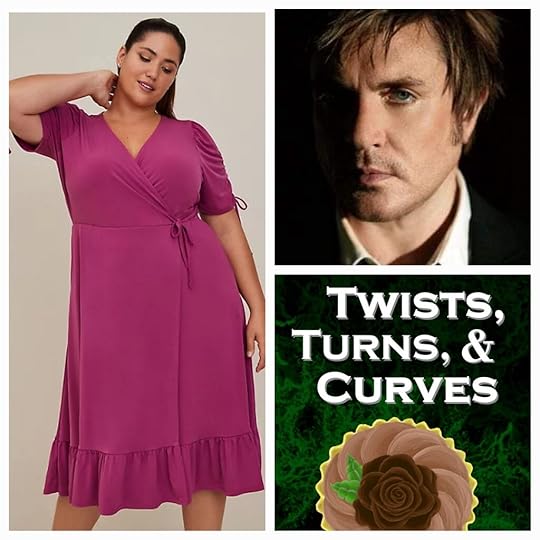
Twists, Turns, & Curves (The Rose Collection Book 2)
Ally’s natural size is 16, and she maintains it with plenty of veggie-heavy soups, salads, and stir-fries. She has a home gym and a daily self-care routine.
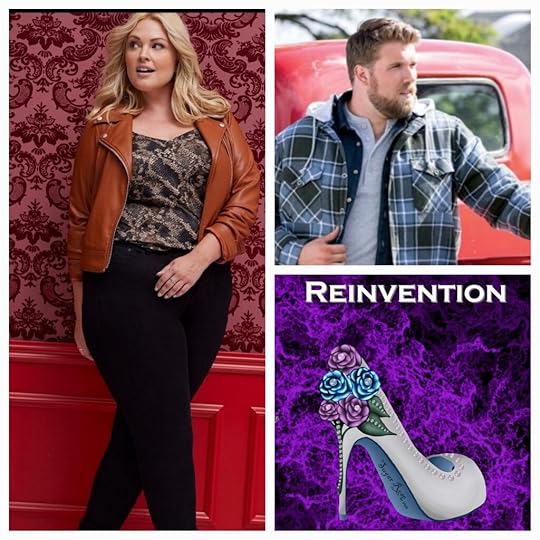
Reinvention (The Rose Collection Book 4)
Kelly has cut sugar and most carbs from her diet due to pain issues — not to lose weight. The home-cooked meals she makes to eat with her family are hearty and healthy. She’s on the go all day but doesn’t have a specific workout she follows.

Wise and Mighty (The Rose Collection Book 5)
See, THAT’S the truth about curvy girls most people don’t want to acknowledge. We are normal.
I’m a vegetarian whose usual diet excludes most superfluous carbs (exceptions made for weekly movie popcorn and thin pizza — and vacation eats). Walking is torment, but I love to swim laps. As for sweatiness — that’s not a plus-sized thing. Women and men of ALL sizes perspire.
But reading about a curvy-girl lead can get a little frustrating when all the character can think about is food and the primary description of her is negative. The faux concern of other characters doesn’t help either.
Don’t get me wrong. I think there is plenty of room for a plus-sized woman who is focused on making changes for her health in the literary landscape. However, if that is the primary focus of the book, it’s going to miss out on some great opportunities for character development.
I love it when a character is digging up issues from their past and relating those problems to their current behavior as an impetus for change. That’s growth!

While participating in the Curvy Girl Promotion, I’ve had the opportunity to read multiple books featuring plus-sized female leads. What I enjoyed the most about the books had NOTHING to do with the character’s size. In Dial P for Perfect, I enjoyed the playful interaction between the FMC and her cat. I liked that her love interest wasn’t due to a singular “meet-cute” but was something that developed over time.
Dial P for Perfect: Sweet Christian Contemporary Romance Novella (You Are on the Air, Book 11)
In The Breakup Project, I empathized with the FMC’s issues with her work and the well-meaning but still hurtful comments her family made about her single status.
The Breakup Project (Original Six Hockey Romance series Book 1)
Nicole had me laughing and staying up way past my bedtime. I admired her insistence that her body wasn’t a problem. If a guy, or clothing manufacturer, couldn’t deal with her, that was their issue.
Nicole: A Sweet Romantic Comedy (Sewing in SoCal book 3)
THOSE are the women I want to read about — and maybe even emulate. They come across the page as real.
The Curvy Girl Promotion is more than just plugging a plus-sized character into the plot. It’s about opening the door to more realistic writing and more life-like characters.
You know, NORMAL women — of every shape and size.
But, since this promotion is focused on the plus-sized, I say, give me those REAL curvy women (and men!) who are dynamically exploring, growing, and changing! Show me more than their outward “curves” — explore their inner contours as well. Let them confess their reluctance to eat in public. Explore how their spiritual journey has been knocked off track by speakers who insist that being fat is a sign of spiritual weakness. Have a character pique my interest when I discover chocolate makes him nauseous. Help me understand a character’s determination to free herself from pain by avoiding simple carbs. Show me the realistic bombardment of advice given by those who DON’T have the character’s best interest at heart but are exercising emotional control over them instead.
Let the words on the page embody the REAL curves of the characters — inside and out. It’s what readers like me have been hungry for.
[image error]September 8, 2022
The Curvy Girl Takes Charge
 My Road to Reinvention
My Road to Reinvention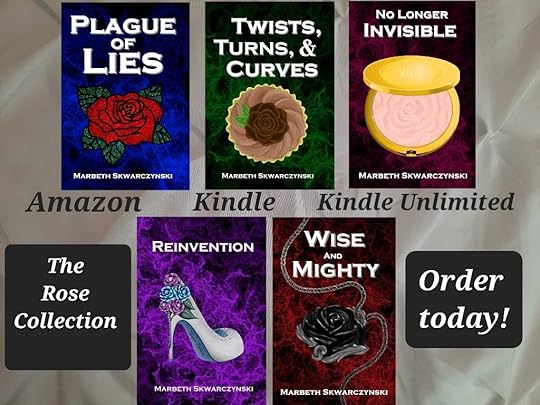
Of all the books in The Rose Collection, Reinvention took the longest to write. For years, I’d get to the halfway mark and suddenly hit a wall. I had the background of my Female Main Character down pat. I knew her attitude, motivations, size 16 A-shaped figure, and life goals as if they were my own. Still, I couldn’t push the story forward.
I ended up shelving the novel and starting a new one. No Longer Invisible was scarily easy to write. My FMC’s inner dialog echoed my own growing up. The format of the story, which I borrowed from Shakespeare’s Two Gentlemen of Verona, fit perfectly with the cultural practices surrounding Julia Williams’ modern yet sequestered life (and yes, I used the play and playwright for her name as well).
No Longer Invisible (The Rose Collection Book 3)
Once Julia’s story was “in the books,” I went back to Reinvention, determined to finish the novel. I wanted to get it out of my mind, so I forced myself to push through.
I did it! My plus-sized former model bounced back from her heartbreak and was ready to take on the world!
But I hated the book.
There was no chance I was going to publish this hollow shell of a novel. It was missing something vital, and I had no idea what it was.
On paper (or in this case, computer screen), the book had everything I wanted. It featured curvy girl heroine, Ally James, a semi-retired plus-sized model who was attempting to refashion her life after a long-term relationship went bad. I gave her a plus-sized best guy friend she could slowly start viewing as a romantic interest (because plus-guys need representation too). I even made sure that her new career would be one that helped women of every size feel and look their best AS THEY ARE.
Ally was active, conscientious, kind, and had a past that was about to rise up and cause all kinds of conflict. I had a sympathetic and supportive guy friend to contast against the rock-star ex trying to ruin her life. I even had a gorgeous cover! The formula was there, so why wouldn’t the story gel?

If you don’t personally know any writers, I’m going to let you in on a little secret: we’re all a little nutter-buttery — as in, we do, in fact, have our characters hijack our stories on occasion. Our imaginary worlds are very real to us. We talk to and listen to our characters. It may sound crazy, but it works. In fact, it’s something we live for. Once a character starts taking control, all I have to do is take dictation, and my life gets much easier.

So, I had the novel done, hated it, and planned to let it rot away next to some casks in the cellars of my hard drive when Ally’s guy friend, Michael, spoke up.
It was unprecedented. None of the pages were in Michael’s POV. He was technically a lead but really acted as a side character who buoyed Ally up as she made the changes in her life. The book was entirely Ally’s. But, it turned out that Michael wanted equal time. He had a story to tell. I’d had no idea. He’d been quiet for years, and now, all of a sudden, he had something to say.
I re-opened the document, skipped past the first chapter, and created a new chapter 2 from Michael’s point of view. His words flowed so fast that I had a hard time keeping up. Michael was desperately in love with Ally but terrified of romance. Keeping her as a friend kept him safe.
That’s when I started noticing Michael’s other “safe” practices. Like how when he ate at home, he carefully measured out all his portions. Like how he shunned sugar. Like how he avoided chocolate as if it was poison.
Stressors made him break out in hives. The smell of chocolate made him nauseous. When he imagined kissing Ally, he pulled back reminding himself that he wasn’t good enough for her — that he wasn’t good enough for anyone.
As the writer, I knew his fear had to have a backstory, and I kept waiting for it to break. The conflict grew more intense. The characters were compelled to act and move due to outward influences, but as for the inner part of Michael’s story, it stayed buried deep.
My sister, who loves me despite my being a nutter, would nod sympathetically as I complained that one of my imaginary friends had stopped speaking to me. He was the one who claimed he had something to say. I rewrote half the novel to give him that opportunity. I set him up and — NOTHING. He refused to speak. The writer in me was frustrated, but my lead character, Ally, was patience personified.
Because Ally provided Michael with a safe environment and a loving friendship, he was able to finally tell his story.
And his story broke me.
There’s an old saying, “No tears in the writer, no tears in the reader.” I sobbed over Michael — and every kid who grew up “stuck” emotionally because of their childhood trauma.
Michael’s revelation didn’t “fix” him. He still had triggers that caused his body to behave outside of his control. But, he was finally able to talk about his past. Ally was the only person he’d ever told and she proved she was worthy of his trust. Ally gave him the words that accurately described his abuse. He’d used the wrong terminology for years — and believed he was responsible for what had happened to him. Ally also encouraged him to find a good therapist to help him move forward. After all, it’s what she’d had to do to get past her own childhood trauma — another story arc that took me by surprise.
Ally, my curvy-girl heroine, is a little different from how plus-sized characters are often portrayed. She doesn’t think about food all the time. She doesn’t binge. She doesn’t hate exercise. She doesn’t see herself as unlovable or unworthy. While she’s not sure about her new career path or how a possible new relationship might work out, she IS confident in how she looks, moves, and feels. She believes that she is worthy of respect and it shows.
It is her confidence that allows Michael to see her as his safety net. She lends him a little of her strength as she prompts him to get the professional help he needs. Ally’s most prominent feature isn’t the size of her body; it is the kindness she shows others.
Reinvention went from being a book I dreaded writing to one I loved. I was proud of my characters and their evolution, so when I released Reinvention in April 2022, I did it with confidence. It took years for the story to come together, but it was definitely worth the wait.
If you haven’t read Reinvention, please download or purchase a copy today. Get to know Ally and Michael. They’re awesome.
Reinvention (The Rose Collection Book 4)
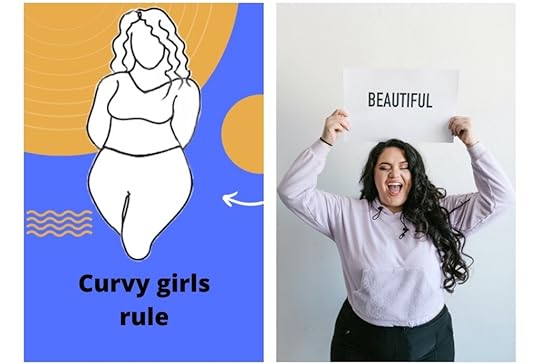
I’m proud to be part of the Curvy Girl Promotion. For novels featuring curvy lead characters, click on the link!
https://heidimcgill822089357.wordpres...
[image error]September 5, 2022
The Curvy Girl Takes the Lead, part two
Proud to be a part of the Curvy Girl Promotion!

 My failure as a romance writer.
My failure as a romance writer.In my quest to create a romance novel as a writing exercise, I elbowed my way into that world, firmly believing in the stereotypes surrounding the genre. I WOULD write a romance novel, but MY book would be different. I decided that I was going to avoid the tropes that I saw as “pitfalls” in many of the books I’d read.
Yes, I was brash, arrogant, and had no earthly idea that those tropes were in place for a reason. But, I had also read several books in a row that hadn’t handled those motifs well. They were the definition of cookie-cutter, and it felt as if the characters were going through the motions to get the author from point A to point Z with a minimum of fuss.
First, I decided I didn’t want a “meet-cute.” I hated the idea of two strangers meeting, having an immediate spark, and then spending the rest of the novel wondering about that handsome/beautiful stranger they’d bumped into a hundred pages before. Instead, I wanted my couple to be acquaintances who grew their friendship and gradually fell in love.
As for conflict? I didn’t want it to be bad communication leading to a simple misunderstanding blown out of proportion. Nope. MY characters were going to take on the world together and, as a result, build their relationship.
Finally, I would end the book with a honeymoon, not a wedding. I thought it was time to showcase the awkwardness of two people whose physical attraction for each other was carefully guarded by purity culture guidelines. I wanted them to yearn for each other, flirt with each other, enjoy the occasional stolen kiss, and then have to hold back— right up to the time when they were expected to rip each other’s clothes off and experience wild, passionate lovemaking. Because, when everyone tells you that being alone together is wrong, that kissing before marriage is wrong, and that even sexual desire for each other is wrong, how exactly are you supposed to “flip that switch” and enjoy a romantic life as a married couple?
I hadn’t seen that in the romance books I’d read, but I felt it was important to address.
So I got to work, creating relatable characters, conflict, and settings. I fell in love with my imaginary friends. When the novel was finished, I sent it off to an agent who specialized in Christian romance. Her take? Put in a meet-cute, create an immediate conflict (between the characters), and end the book at the wedding because a book can’t be classified as “romance” without those conventions.
Huh. I hadn’t realized those tropes were actual “rules” for the genre.
I also hadn’t realized how talented writers could take those requirements and make them so fresh and engaging that I didn’t realize what they were doing until I was well into the story before discovering it was classified as a romance.
That’s when it finally occurred to me that some of my favorite books were romance novels. I grew up with a ratty old copy of Rose Galbraith by Grace Livingstone Hill that got rattier the more I reread it. When I was sixteen, I used money from my first paycheck to purchase Love Comes Softly by Janette Oke. More recently, I read What Love Washed Up by Catherine Brusk. I was so taken with the book, that I had to stop halfway through to write a “pre” review. It was deep, funny, and beautifully crafted.
Each of these favorite books played with the tropes beautifully, not always following them exactly, but staying far within the literary guidelines and telling fresh, new stories.
Rose GalbraithLove Comes Softly (Love Comes Softly Book #1)What Love Washed Up (Finding Faith Book 1)Still, determined to continue my experiment, I returned to the novel and started tinkering. I moved up Ty and Caroline’s first interactions in the book to the first chapter, just after she gets fired from her teaching career. It’s not exactly a meet-cute, but it sets their relationship in motion as more than just acquaintances. As for the conflict between them? I made sure it came from outside sources who planted seeds of doubt in the mind of my curvaceous main character. I made her constantly question her desirability and worthiness. Finally, I wrote an alternative ending, losing that honeymoon scene I’d wanted so badly.
While I liked most of the changes I’d made in the novel, I hated the ending. Everything turned out okay, though, because the agent rejected the corrected manuscript. I put the original ending back in and did another rewrite. I decided I was going to publish the book myself.
Twists, Turns, and Curves puts the curvy girl firmly in the lead role. We watch Caroline shrug off the chains of her old life. In the past, she’s felt less than worthy of love, friendship, and even happiness. That worthlessness stemmed from how other people viewed her appearance, not her spiritual fruit. Once she left her toxic workplace/place of worship, she began growing and discovering her worth. Caroline Taft became that friend we all enjoy sitting with as we recap our day over a cup of tea.
Caroline also discovered that Ty loved her from afar for the two years he’s known her. She’s everything he finds attractive inside and out. He’s held back, though. He wanted to make sure he wouldn’t be rejected — or hurt — again. Ty has his own past issues, and he aches for kindness. James, his brother, suggested Ty ask out the teacher from his son’s school, knowing she was Ty’s type. Still, Ty takes his time, making sure Caroline is as beautiful on the inside as she is on the outside. The two were little more than acquaintances at the beginning of the novel, but they started building a friendship with an eye toward romance. I cheered them every step of the way.
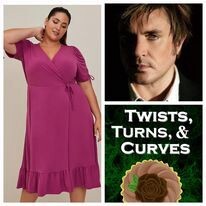
Twists, Turns, and Curves may be a failure as a genuine romance novel — full of sweet tropey goodness — but it solidified my writing style and helped me understand my genre. I write contemporary Christian fiction that explores the complex problems facing many church organizations (and their members) today . Most of those issues stem from the insidious root of spiritual abuse.
The weird thing is I didn’t realize Caroline’s treatment WAS abuse until I started writing yet ANOTHER “final” edit. I, too, had been so far inside of a toxic situation, that I couldn’t see it for what it was.
While Caroline developed her friendship-turned-romance with Ty, she also had to deal with economic abuse (I was taught it was “sacrifice”), sizism (I was taught my weight problems were rooted in spiritual deficit), and overwork (I served the leadership’s plans as a way of serving God). These issues continue to plague those who work in full-time Christian service.
Caroline has a five-year teaching career that ends abruptly just before spring break, with no more explanation than the “ministry can’t afford to keep you on.” Since she lives in an apartment partially paid for by the church/school, she’ll lose her housing as well. Still, she’s expected to finish the school year and continue her unpaid extra work for the ministry up until the day she leaves — all with a happy expression and good attitude. Once she goes, she’s expected to return to her parents' home and get another low-paying (sacrificial) ministry job. It’s a crazy scenario to those in the “real world,” but in the world of full-time Christian service, it’s an all-too-familiar situation. (One that I actually thought was normal once upon a time.)
Twists, Turns, & Curves (The Rose Collection Book 2)
While perpetually rewriting, I decided to put Caroline in the same universe as my first novel, Plague of Lies, and suddenly I had the kernel of an idea for a contemporary Christian fiction series: The Rose Collection. Not only did I have a recurring motif (a rose symbolizing protection and sweetness in one beautiful image), but I also stumbled upon the overarching theme of the novels.
Plague of Lies (The Rose Collection Book 1)
Each book in The Rose Collection centers on the recovery from spiritual abuse and its results (economic, physical, sexual abuse). None of my characters live in a perfect little bubble. They live in the real world and deal with real recovery issues. Within the pages, I make room for their personal growth, including their romantic entanglements. I may be a failure as a romance novelist, but my characters find love and kindness in healthy relationships — despite my embracing a different genre.
Are they romance novels? Technically, no.
Is there romance IN the novels? ABSOLUTELY!
Curvy girls abound in The Rose Collection: Cheryl, in Plague of Lies, Caroline in Twists, Turns, and Curves, Nana and Denise in No Longer Invisible, Ally in Reinvention, and Kelly in Wise and Mighty. I write about curvy girls because I am one and because they just don’t get the respect and love they deserve on the pages of most books.
No Longer Invisible (The Rose Collection Book 3)Reinvention (The Rose Collection Book 4)Wise and Mighty (The Rose Collection Book 5)Curvy girls SHOULD live their dreams, get the job, find themselves, empower others, feel respected, and stand strong. Even if the author fails to write them a genuine romance novel to star in, it’s time for curvy girls to take the lead.
Fortunately, the Curvy Girl Promotion features several talented Christian romance authors, each of whom has cast a plus-sized heroine in a story that needed to be told.
Click on the link at the top of this blog for a complete list of the authors and their books. Support your favorite writers by purchasing and reading their novels. Don’t forget to leave a review encouraging others to read their books as well!
And be kind to the curvy girls in your life.
Especially if that curvy girl is you.
 [image error]
[image error]
September 1, 2022
The Curvy Girl Takes the Lead, part one

I was ecstatic when Heidi Gray McGill invited me to participate in the Curvy Girl Promo. I immediately downloaded the books that were offered and found some new favorite authors. (Click the link above to learn more.) I was excited to realize that my own curvy girls from The Rose Collection series of novels fit right in!
I love my novel characters, and my curvy girls are incredibly close to my heart. As for the “romance” aspect of this promotion, well, in that way, I’m a bit of a failure. But not for lack of trying.
My one and only foray into writing an actual “romance” novel didn’t quite go as I expected. It started after I had sent my manuscript of Plague of Lies off to be ogled by the judges of a Christian writing competition. The feedback was encouraging, but my book didn’t make it out of the middle of the pack. So, I did what every author does when their work is critiqued — yet another slash and burn edit.
But during my days of deep cuts and tightened writing, I was drawn back to the competition guide. So many categories and genres! Since I was a teacher at the time (and therefore a glutton for punishment), I set myself a little homework — I was determined to write a book from each genre.
What was I thinking?
Well, I was a new and excited author looking for a challenge — with no clue what such a ridiculous assignment would entail. But that germ of a plan was vital to my writing journey. It helped me discover the genre that was perfect for my style.
The very first category listed in the competition guide was Christian romance. It wasn’t my go-to category for reading, but I’d had some great experiences with authors who knew how to create a dynamic story and I was up for experimenting with the genre.
I decided right from the start that my heroine was going to be a curvy girl. After all, I was a plus-sized woman working hard every day in full-time ministry while married and raising two kids, so I had the street cred.
I began creating my FMC for my second novel, Twists, Turns, and Curves. Caroline Taft is a dark-haired/skinned beauty with an “A” body type (smaller on top than on the bottom) and a workaholic lifestyle. She also has a desperate crush on a gorgeous events hall owner whose nephew is in her 4th-grade class. Caroline doesn’t see herself as worthy of his attention. Or anyone’s attention. She’s a behind-the-scenes worker who fades into the machinery of her church’s ministries. Caroline doesn’t push herself forward. She doesn’t want to. After all, she was raised to believe the usual lies about curvy girls and she doesn’t want to get called out. I knew what that was like because I was raised to believe them too.
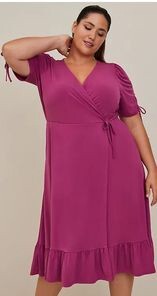
Right from the beginning, I wanted to disabuse people of their plus-sized prejudices concerning curvy women. These were suppositions I’d heard my entire life (even when I wasn’t plus-sized), and I knew they were patently untrue. Caroline would be my vehicle to show exactly how wrong those ideas were, starting with
Lie number 1:Women are plus-sized because they are lazy.Much of Caroline’s work schedule in the book was based on my own experiences. While Caroline taught 4th grade full-time, I taught 7–12th-grade history, literature, and fine arts/electives (and ran several after-school clubs in an effort to give my students a more well-rounded educational experience). Because I set Caroline in a church-run Christian school, I added the usual expected “extra mile” ministries that come with working in a full-time Christian service environment: teaching a Sunday school class, Sunday night kid’s choir, and the Wednesday night Adventure Bible Club class. Then there’s the obligation of going door-knocking every Saturday morning.
Despite her ridiculously busy schedule, Caroline is branded as an example of “lazy,” “unspiritual,” and “undisciplined” solely because of her size. The insistence of a traveling evangelist that all “big girls” fall into these categories goes unchallenged by the very congregation Caroline serves.
How many times have I sat in church, absolutely crushed by crude “jokes” about “fat women” from the pulpit, and wondered what more I could possibly fit into my schedule to prove those speakers wrong? Later, when I started to really realize how wrong it was for these men (many of the plus-sized themselves) to denigrate women this way, my objections were met with the suggestion that I learn how to “take a joke.”
But those weren’t jokes. Jokes are funny. Those statements from the pulpit were intentionally hurtful and cruel.
As a plus-sized woman in the pew, I felt like I was expected to reform my body inside and out by sheer willpower. Working out at a gym was discouraged. Dancing was discouraged. Yoga was discouraged. What did that leave? Strict diets and walking? But watch what you wear when you walk. You don’t want to attract too much attention to yourself. And there’s a potluck next week. Bring something yummy to share.
There was never any consideration in those sermons, jokes, or illustrations for a person’s “natural” shape or body type. In my novel, Caroline’s roommate, Kay, is naturally thin. She eats the same food as Caroline and works out just as often. She teaches third grade and has similar ministries added to her workload. Yet, she remains her same smaller size. These two women have very different body types and metabolisms. Yet, the idea that not everybody is the same is incomprehensible to some in spiritual leadership. Simply put, if we didn’t conform to the leadership/speaker’s sense of what was appropriate, it must be because we were in rebellion or just plain lazy. It didn’t have anything to do with the sheer impossibility of making healthy changes while within the system.
My self-esteem took a lot of beatings over the years. It was pretty easy to put Caroline in the same mindset.
Lie number 2:Women are plus-sized because they gorge themselves at every opportunity.I taught for eighteen years and my diet was overall pretty poor. Mostly because I was pretty poor. My biggest regret working in full-time ministry was raising my kids in poverty. Looking back, that specific issue always hits me the hardest.
While we always tried to have some fresh fruit and veg in the house, the majority of our meals were foods that were cheap and filling. Every dinner featured a large portion of starch: potatoes, pasta, or rice. The meat was always the cheapest cut (we were able to save a little there because I’m a vegetarian). Vegetables were whatever was cheapest that week.
Lunches were fairly easy. Ninty-nine-cent frozen pasta dishes, single-serve pizzas, or burritos were the usual. Because I couldn’t always leave my desk, I’d down my lunch and a snack bag (or two) of chips in a five-minute break between classes.
Personally, I didn’t gorge at every opportunity, but I did graze on less-than-desirable food choices throughout the day. Fun-sized Snickers bars, Little Debbie snacks, and Flaming Hot Cheetos were easily available, quickly consumable, and full of flavor. Still, my eating habits were influenced more by my work schedule than my appetite. Once I left teaching, it became so much easier to linger over a big salad or bowl of homemade soup. Chips, pasta, potatoes, and rice are no longer a part of my diet. I also have time to move more since I’m not tied to a classroom and desk. (And I can go to the bathroom whenever I want!)
When writing Caroline, I made sure she showed the truth about professional teachers living in poverty. That reality is reflected in her food choices and her schedule.
Lie number 3:Plus-sized women are sloppy and careless.I hate this supposition. When I was teaching, I never set foot on campus without being dressed in my most professional clothing. My hair was always done and my makeup was always on. I taught class after class with only a quick trip or two to the bathroom between classes and ate at my desk. By the end of the day, my workstation was messy, but I wasn’t. When I went home in the evening, it took the last of my energy to cook for my family and throw a load of laundry into the washer. I rarely cleaned. My house was a wreck, but I wasn’t. If it weren’t a church night, I’d dress in comfy clothes and snuggle up on the couch with my husband and kids. I didn’t have the neatest classroom and home, but it wasn’t just because I loathe housekeeping/cleaning (which I do). It was because I was busy (too busy) and exhausted.
Yet, I never let the facade of professionalism slide, with the exception of the occasional leaking of tears due to depression and stress.
Caroline feels that stress too. There is exhaustion in never quite being good enough. Of never doing enough. In someone always wanting more.
In chapter one, I establish that Caroline is always the consummate professional. She looks her best every day. Yet, her boss/pastor can’t see past her weight to her loyalty and outstanding work ethic.
Lie number 4:Plus-sized women sit around all day and never get any exercise.By chapter two, Caroline is in the gym, doing her usual workout (despite some discouragement from her church leadership). I wanted my curvy girl character to remind people that we do, in fact, exercise. It isn’t easy. People are casually cruel to the plus-sized people working out next to them. We can put in our earbuds and blast music directly into our brains to keep the snide remarks at bay, but it doesn’t stop the up-and-down gazes and the sneers of disgust by those who have yet to understand that every body needs to move to be healthy — even if that body doesn’t look like theirs.
Exercise wasn’t easy to get when I was teaching, but I certainly tried. Sometimes, it was just dancing alone in my bedroom or taking a short walk. My lack of movement was more of a time/exhaustion issue until it became a pain issue. It’s hard to move when knees, feet, ankles, and back are in constant agony. Still, I pushed through, trying to find something that worked for me. Finally, I rediscovered the joy of swimming — the one activity I can do completely pain-free. It’s bliss.
Caroline loves to work out at the gym. There she can push her body and clear her mind. She is under obligation to no one but herself.
It is also the place where she is asked out on her first date by a guy she’s had a crush on for two years, the gorgeous Ty Lang.

But that’s a subject for another blog post when I share exactly how my “romance novel” failed miserably. And thank God it did, because Twists, Turns, and Curves became something more suited to my newly discovered writing style and my genre of choice.
TO BE CONTINUED…
While you wait for the rest of this story, please check out the well-written and entertaining books offered in the Curvy Girl promo. You won’t be disappointed!
[image error]The Curvy Girl Takes the Lead (part one)

I was ecstatic when Heidi Gray McGill invited me to participate in the Curvy Girl Promo. I immediately downloaded the books that were offered and found some new favorite authors. (Click the link above to learn more.) I was excited to realize that my own curvy girls from The Rose Collection series of novels fit right in!
I love my novel characters, and my curvy girls are incredibly close to my heart. As for the “romance” aspect of this promotion, well, in that way, I’m a bit of a failure. But not for lack of trying.
My one and only foray into writing an actual “romance” novel didn’t quite go as I expected. It started after I had sent my manuscript of Plague of Lies off to be ogled by the judges of a Christian writing competition. The feedback was encouraging, but my book didn’t make it out of the middle of the pack. So, I did what every author does when their work is critiqued — yet another slash and burn edit.
But during my days of deep cuts and tightened writing, I was drawn back to the competition guide. So many categories and genres! Since I was a teacher at the time (and therefore a glutton for punishment), I set myself a little homework — I was determined to write a book from each genre.
What was I thinking?
Well, I was a new and excited author looking for a challenge — with no clue what such a ridiculous assignment would entail. But that germ of a plan was vital to my writing journey. It helped me discover the genre that was perfect for my style.
The very first category listed in the competition guide was Christian romance. It wasn’t my go-to category for reading, but I’d had some great experiences with authors who knew how to create a dynamic story and I was up for experimenting with the genre.
I decided right from the start that my heroine was going to be a curvy girl. After all, I was a plus-sized woman working hard every day in full-time ministry while married and raising two kids, so I had the street cred.
I began creating my FMC for my second novel, Twists, Turns, and Curves. Caroline Taft is a dark-haired/skinned beauty with an “A” body type (smaller on top than on the bottom) with a workaholic lifestyle. She also has a desperate crush on a gorgeous events hall owner whose nephew is in her 4th-grade class. Caroline doesn’t see herself as worthy of his attention. Or anyone’s attention. She’s a behind-the-scenes worker who fades into the machinery of her church’s ministries. Caroline doesn’t push herself forward. She doesn’t want to. After all, she was raised to believe the usual lies about curvy girls and she doesn’t want to get called out. I knew what that was like because I was raised to believe them too.

Right from the beginning, I wanted to disabuse people of their plus-sized prejudices concerning curvy women. These were suppositions I’d heard my entire life (even when I wasn’t plus-sized), and I knew they were patently untrue. Caroline would be my vehicle to show exactly how wrong those ideas were, starting with
Lie number 1:Women are plus-sized because they are lazy.Much of Caroline’s work schedule in the book was based on my own experiences. While Caroline taught 4th grade full-time, I taught 7–12th-grade history, literature, and fine arts/electives (and ran several after-school clubs in an effort to give my students a more well-rounded educational experience). Because I set Caroline in a church-run Christian school, I added the usual expected “extra mile” ministries that come with working in a full-time Christian service environment: teaching a Sunday school class, Sunday night kid’s choir, and the Wednesday night Adventure Bible Club class. Then there’s the obligation of going door-knocking every Saturday morning.
Despite her ridiculously busy schedule, Caroline is branded as an example of “lazy,” “unspiritual,” and “undisciplined” solely because of her size. The insistence of a traveling evangelist that all “big girls” fall into these categories goes unchallenged by the very congregation Caroline serves.
How many times have I sat in church, absolutely crushed by crude “jokes” about “fat women” from the pulpit, and wondered what more I could possibly fit into my schedule to prove those speakers wrong? Later, when I started to really realize how wrong it was for these men (many of the plus-sized themselves) to denigrate women this was, my objections were met with the suggestion that I learn how to “take a joke.”
But those weren’t jokes. Jokes are funny. Those statements from the pulpit were intentionally hurtful and cruel.
As a plus-sized woman in the pew, I felt like I was expected to reform my body inside and out by sheer willpower. Working out at a gym was discouraged. Dancing was discouraged. Yoga was discouraged. What did that leave? Strict diets and walking? But watch what you wear when you walk. You don’t want to attract too much attention to yourself. And there’s a potluck next week. Bring something yummy to share.
There was never any consideration in those sermons, jokes, or illustrations for a person’s “natural” shape or body type. In my novel, Caroline’s roommate, Kay, is naturally thin. She eats the same food as Caroline and works out just as often. She teaches third grade and has similar ministries added to her workload. Yet, she remains her same smaller size. These two women have very different body types and metabolisms. Yet, the idea that not everybody is the same is incomprehensible to some in spiritual leadership. Simply put, ff we didn’t conform to the leadership/speaker’s sense of what was appropriate, it must be because we were in rebellion or just plain lazy. It didn’t have anything to do with the sheer impossibility of making healthy changes while within the system.
My self-esteem took a lot of beatings over the years. It was pretty easy to put Caroline in the same mindset.
Lie number 2:Women are plus-sized because they gorge themselves at every opportunity.I taught for eighteen years and my diet was overall pretty poor. Mostly because I was pretty poor. My biggest regret working in full-time ministry was raising my kids in poverty. Looking back, that specific issue always hits me the hardest.
While we always tried to have some fresh fruit and veg in the house, the majority of our meals were foods that were cheap and filling. Every dinner featured a large portion of starch: potatoes, pasta, or rice. The meat was always the cheapest cut (we were able to save a little there because I’m a vegetarian). Vegetables were whatever was cheapest that week.
Lunches were fairly easy. Ninty-nine-cent frozen pasta dishes, single-serve pizzas, or burritos were the usual. Because I couldn’t always leave my desk, I’d down my lunch and a snack bag (or two) of chips in a five-minute break between classes.
Personally, I didn’t gorge at every opportunity, but I did graze on less-than-desirable food choices throughout the day. Fun-sized Snickers bars, Little Debbie snacks, and Flaming Hot Cheetos were easily available, quickly consumable, and full of flavor. Still, my eating habits were influenced more by my work schedule than my appetite. Once I left teaching, it became so much easier to linger over a big salad or bowl of homemade soup. Chips, pasta, potatoes, and rice are no longer a part of my diet. I also have time to move more since I’m not tied to a classroom and desk. (And I can go to the bathroom whenever I want!)
When writing Caroline, I made sure she showed the truth about professional teachers living in poverty. That reality is reflected in her food choices and her schedule.
Lie number 3:Plus-sized women are sloppy and careless.I hate this supposition. When I was teaching, I never set foot on campus without being dressed in my most professional clothing. My hair was always done and my makeup was always on. I taught class after class with only a quick trip or two to the bathroom between classes and ate at my desk. By the end of the day, my workstation was messy, but I wasn’t. When I went home in the evening, it took the last of my energy to cook for my family and throw a load of laundry into the washer. I rarely cleaned. My house was a wreck, but I wasn’t. If it weren’t a church night, I’d dress in comfy clothes and snuggle up on the couch with my husband and kids. I didn’t have the neatest classroom and home, but it wasn’t just because I loathe housekeeping/cleaning (which I do). It was because I was busy (too busy) and exhausted.
Yet, I never let the facade of professionalism slide, with the exception of the occasional leaking of tears due to depression and stress.
Caroline feels that stress too. There is exhaustion in never quite being good enough. Of never doing enough. In someone always wanting more.
In chapter one, I establish that Caroline is always the consummate professional. She looks her best every day. Yet, her boss/pastor can’t see past her weight to her loyalty and outstanding work ethic.
Lie number 4:Plus-sized women sit around all day and never get any exercise.By chapter two, Caroline is in the gym, doing her usual workout (despite some discouragement from her church leadership). I wanted my curvy girl character to remind people that we do, in fact, exercise. It isn’t easy. People are casually cruel to the plus-sized people working out next to them. We can put in our earbuds and blast music directly into our brains to keep the snide remarks at bay, but it doesn’t stop the up-and-down gazes and the sneers of disgust by those who have yet to understand that every body needs to move to be healthy — even if that body doesn’t look like theirs.
Exercise wasn’t easy to get when I was teaching, but I certainly tried. Sometimes, it was just dancing alone in my bedroom or taking a short walk. My lack of movement was more of a time/exhaustion issue until it became a pain issue. It’s hard to move when knees, feet, ankles, and back are in constant agony. Still, I pushed through, trying to find something that worked for me. Finally, I rediscovered the joy of swimming — the one activity I can do completely pain-free. It’s bliss.
Caroline loves to work out at the gym. There she can push her body and clear her mind. She is under obligation to no one but herself.
It is also the place where she is asked out on her first date by a guy she’s had a crush on for two years, the gorgeous Ty Lang.

But that’s a subject for another blog post when I share exactly how my “romance novel” failed miserably. And thank God it did, because Twists, Turns, and Curves became something more suited to my newly discovered writing style and my genre of choice.
TO BE CONTINUED…
While you wait for the rest of this story, please check out the well-written and entertaining books offered in the Curvy Girl promo. You won’t be disappointed!
[image error]


